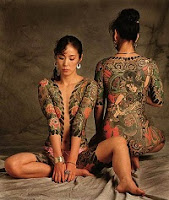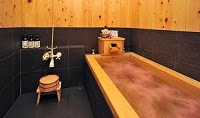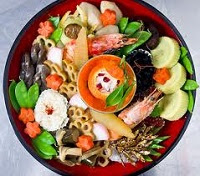 |
| All tatted up and no place to go. Images of "The Floating World" have always been popular themes for Japanese tattoo artists. |
In the Floating World, Yet Not of It
Every winter before New Year's me and my mom used to thoroughly clean the house for the coming new year, what "spring cleaning" is to Western culture. Then we'd sit around drinking green tea, eating rice balls, and we'd pretty much call it a year.
In fact, "cleansing" is a big theme in Japanese culture all throughout the year due to Japan's Buddhist and Shinto background. The reason for this is the underlying theme in these spiritual paths is that individuals are not to get attached to "The Floating World" that surrounds them.
The Floating World is just going to pass away, like waves of a river flowing past us, so we're advised to keep ourselves dry and safe on a spiritual river bank of mental/emotional "detachment" and "equanimity." From that vantage point, we just observe wave after wave of the ephemeral phenomena of that world float by, without getting swept away by it, without getting drowned in it.
The Floating World, of course, denotes the mundane realm. It was even a popular genre of art with Japanese printmakers. It was called ukiyo-e, "art of the floating world." All our lives we are to be "in the world" lovingly attending to all our responsibilities of work and family. Yet, we're advised to keep an awareness of being "not of it," knowing we are spiritual beings temporarily experiencing a human life.
We're to remember that we will move on after this life, and everything we know and love will pass away, as well. Nothing is permanent. Little reminders are scattered within the culture to help people remember these things. It's a subconscious awareness. No one really talks about it, yet it is always there.
 |
| "O-furo," a Japanese bathtub. One sits on the stool at left, scrubs with soap, rinses with the bamboo pail on top of it, then soaks in the tub, at right. Ofuro are often large because traditionally whole families bathe together, and public bath houses remain a mainstay in Japan. Click here: Sento |
Bathing the Spirit
"The love you withhold is the pain that
you carry, lifetime after lifetime."
--Alex Collier, ET contactee
you carry, lifetime after lifetime."
--Alex Collier, ET contactee
The act of bathing, for instance, advances this thinking. The real purpose of the bath is internal cleansing, not getting the outer body clean. Scrubbing down and rinsing the physical body are actually done quickly outside the bathtub. The important part is soaking in the tub after the superficial scrub down. That's where the real cleansing takes place. That's where internal toxins get a chance to come to the surface (literally), and then get released. "Holding in" internal toxin is unhealthy.
Likewise, Buddhism and Shintoism teach that we're to search our spirits, identify our internal toxins, and release them. We strive to let go of anger, grudges, jealousies, vengeful, cruel thoughts, and thoroughly cleanse these things from our spirits. Otherwise, they say, these things grow into the issues we'll deal with again in future incarnations --different times, different places, but the same individuals and the same issues.
Unlike the literal hell that we're "sent to" by the angry god of Western culture, in Asia they believe the only hell we experience is re-living the negative karma we ourselves created by and for ourselves through our treatment of ourselves and others, a matter of cause and effect, not punishment. We will wallow in this muck and mire for as many lifetimes as it takes before we transcend and learn to love unconditionally. This is why the theme of cleansing is so important in Japan specifically, and in Asia, ubiquitously. There's no savior who does this for us, they believe (not even Buddha, nor our ancestors). It's something we must do ourselves, the bed we make in which we must then sleep.
Keeping our physical bodies clean is a daily thing, and yesterday's bath means nothing today. Likewise, keeping our spiritual bodies clean isn't a one-time thing done through some one-size-fits-all ritual. It takes frequent effort. To this end, Asian spiritual paths recommend such things as maintaining a regular meditation practice to help in this effort.
Year-end Parties
Another tool to help people keep karmically "clean" in Japan is symbolized by year-end parties. This is where employees apologize to each other and clear the air of grievances. Then they celebrate the new energy this act of grace creates for the new year. It's not supposed to be an excuse to get drunk, though there's plenty of that, of course. In fact, some "social lubricant" probably helps the heartfelt apologies flow. But forgiveness is the point of the procedure, and it's bad form to start a new year with an old grudge. Some, like my mom, even consider it very bad luck.
__________________________________________
Well, some of the things I mention above are included in the following overview of Japanese New Year traditions below, written by Shizuko Mishima for About.com. Enjoy, and here's wishing you a....
明けましておめでとうございます
Akemashite omedetou gozaimasu!
Akemashite omedetou gozaimasu!
Happy New Year!
Shiwasu is a Japanese word for December which literally means "teachers run around." This word reflects the busiest month of the year. How do the Japanese spend the end of the year?
During December, bounenkai (forget-the-year-parties) gatherings are held among co-workers or friends in Japan. It's a Japanese custom to send o-seibo (end-of-year gifts) around this time of the year. Also, it's customary to write and mail nengajo (Japanese New Year's postcards) in December so that they are delivered on New Year's Day.
An important Japanese end-of-year custom is oosoji which means extensive cleaning. In contrast to spring cleaning that is common in the US, oosoji is traditionally practiced when the weather is rather cold. It's important for the Japanese to welcome a new year with a clean state, and all cleanings are done at home, work, and school before New Year's holiday.
When the cleaning is done, New Year's decorations are usually placed by December 30 around and inside houses. A pair of kadomatsu (pine and bamboo decorations) is placed at the front door or at the gate. Shimekazari or shimenawa made with a twisted straw rope, paper decorations, and a tangerine are hung in various locations to bring good luck. It's said that bamboo, pine, tangerines are symbols of longevity, vitality, good fortune, and so on. Another New Year's decoration is kagamimochi which usually consists of two round shaped mochi rice cakes one on top of the other.
Since it's traditional for the Japanese to eat rice cake (mochi) during New Year's holidays, mochitsuki (pounding of mochi rice to make mochi) is done at the end of the year. People traditionally use a wooden mallet (kine) to pound steamed mochi rice in the stone or wooden mortar (usu). After the rice becomes sticky, it is cut into small pieces and shaped into rounds. As prepackaged mochi rice cakes are commonly sold at supermarkets nowadays, mochitsuki is not as common as it used to be. Many people use automatic mochi-pounding machines to make mochi at home. In addition, a plenty of New Year's food (osechi ryori) are prepared before New Year's holiday.
As many people are off work from the last weekend of December to the first weekend of January in Japan, it's one of Japan's busiest travel seasons. After the all busy work, the Japanese usually spend New Year's Eve (oomisoka) rather quietly with the family. It is traditional to eat soba (buckwheat noodles) on New Year's Eve since thin long noodles symbolize longevity. It is called toshikoshi soba (passing the year noodles). Soba restaurants around the country are busy making soba on New Year's Eve. People say to each other "yoi otoshiwo" which means "Have a nice year passing" at the end of the year.
Before midnight on New Year's Eve, temple bells across Japan begin to toll slowly 108 times. It's called joya-no-kane. People welcome the new year by listening to the sound of temple bells. It is said that the temple bell tolls purify ourselves of our 108 worldly desires. At many temples, visitors can strike joya-no-kane. You might need to arrive early to participate in tolling the bells.
___________________________________________________
Videos
.
Videos
A visit to a shrine. Note how visitors must first rinse their hands before approaching the shrine. Traditionally, they would also rinse their mouths, but I guess for sanitation reasons that part is no longer practiced. This rinsing is also done by practitioners  before a tea ceremony, and at other occasions --again, the theme of "cleansing."
Why does every family seem to have an Uncle So-and-So who's the only one in the family who knows how to make a such-and-such? The rope and paper thingy this uncle is making symbolizes lightning bolts in Shinto, and is placed at sites considered holy. This includes shrines, but could also include natural phenomena like sacred mountains (ex: Mt. Fuji), ancient trees, rivers, lakes, etc.
Thanks for reading (and watching). Peace.
.



No comments:
Post a Comment